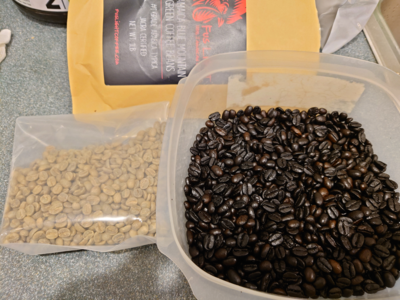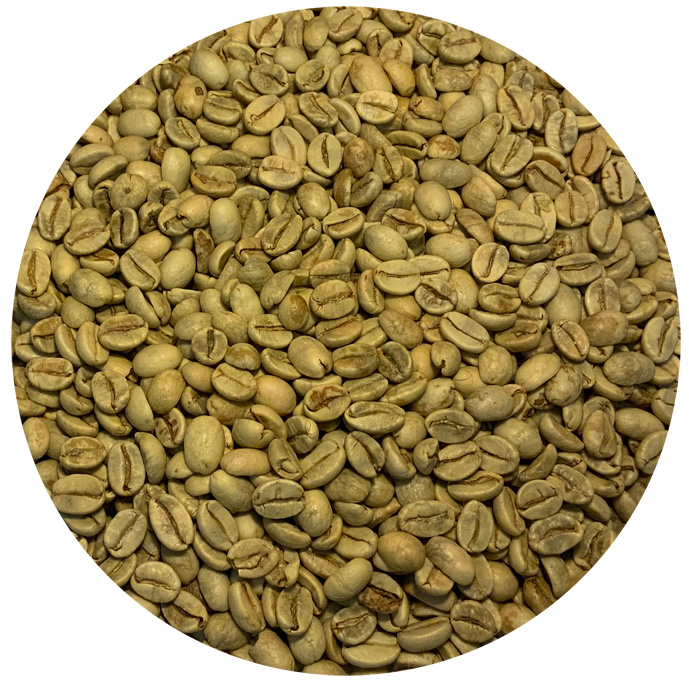- Nov 12, 2017
- 85
- 83
Fascinating thread. I'm going to go back and read the entire thread soon.
I'm a pour-over guy too. You bet I've seen the bubbles! Guess I attributed it to the <74% close-packing of coffee grounds with air...so that was the air purging out. But now that you mention it, it does seem to lessen the further the beans are from their roast date...negating my interstitial air theory and backing up your CO2 out-gassing theory....Carbon dioxide!...
1. Yep they increased in size as usual, see here:Interesting. I've never roasted Jamaican beans, but I've also never had chaff-free roasted beans. I have roasted every 2-3 weeks for the last several years (20 ounces per roast).
A couple questions come to mind.
1. Did they increase in size (40% to 100%) during the roast?
2. Since you took them to a dark roast, did you hear the first and second crack?

HD, great point on the natural process results for chaff. Did not know that. I'll have to check my purchase history spreadsheet to see if I have any natural process beans.Do you know how they were processed?
Natural process beans tend to have less chaff than dry process beans because if the fermentation process.
Also new-ish to the forum. Didn't know there was a coffee roasting cross over here. Love it!
Wanted to try smoking/roasting over coals many times, but never gave it a shot yet.
Excellent post! Thanks for sharing. I've never tried beans from that part of the world. I'll definitely research that area.We are currently drinking Indian Monsoon Malabar, which is essentially left in an open air warehouse during the monsoons in India, aging it in a unique way. One result is there is no chaff remaining.

 burmancoffee.com
burmancoffee.com

Do you know how they were processed?
Natural process beans tend to have less chaff than dry process beans because if the fermentation process.
Also new-ish to the forum. Didn't know there was a coffee roasting cross over here. Love it!
Wanted to try smoking/roasting over coals many times, but never gave it a shot yet.
Probably a pretty low care ratio here, but I just realized I misspoke above. Dry and natural process are the same/similar. Wet processed/washed will generally have less chaff than dry/natural.Do you know how they were processed?
Natural process beans tend to have less chaff than dry process beans because if the fermentation process.
Also new-ish to the forum. Didn't know there was a coffee roasting cross over here. Love it!
Wanted to try smoking/roasting over coals many times, but never gave it a shot yet.
So the taste test was done today and the results... the best coffee she has ever had!
I tell you what, if this is wet processed and it removed all the chaff for me then I'll be going this route from here on out.
| Central America | El Salvador | Balsamo-Quezaltepec, Municipality Nejapa | SHG | Finca El Cipres | Wet process, Patio Sun-dried |
| Africa | Burundi | Mururui Hill in Sogestal Kayanza Northern Burundi | A1 | Dusangirijambo Co-op | Wet Processed, sun dried raised beds |
| Central America | El Salvador | Balsamo-Quezaltepec, Municipality Nejapa | SHG | Finca El Cipres | Wet process, Patio Sun-dried |
| Central America | El Salvador | 19.45 oz Balsamo-Quezaltepec, Municipality Nejapa + 2.55 oz Ataco, Ahuachapan | SHG | Finca El Cipres | Wet process, Patio Sun-dried |
| Central America | El Salvador | Ataco, Ahuachapan | SHG | Finca Villa Maria (Dona Maria Alcira Celis) | Wet Processed,Patio Sun-dried |
| South America | Peru | Huabal | SHB | Jaen Granjeros | Mechanically Washed, Sun Dried |
| Central America | Costa Rica | Dota, Tarrazu | SHB | El Conquistador | Mechanically Washed, Sun Dried |
| South America | Brazil | Lambari, Minas Gerais | Estate | Amecafe Cooperative | Dry Process (natural), patio sun-dried |
| South America | Brazil | Cerrado Mineiro | Estate | Patroncinio Ricardo Vagne | Dry Process (natural), patio sun-dried |
| Mexico | Mexico | Sierra Madre de Chiapas | SHG | Coop Farming | Mechanically Washed, Sun Dried |
| South America | Peru | El Paraiso Yoner Arevalo | SHB | Yoner Arevelo | Mechanically Washed, Sun Dried |

